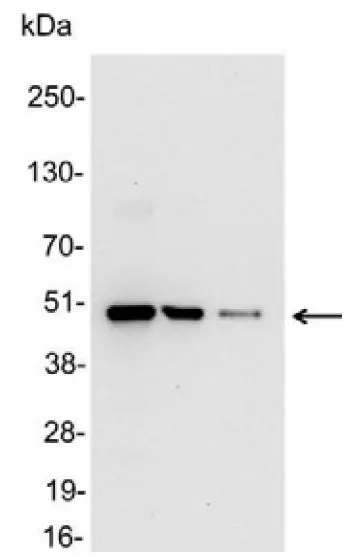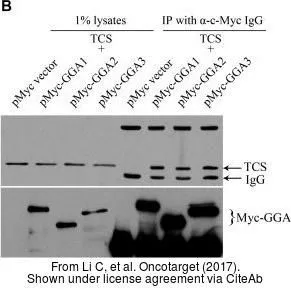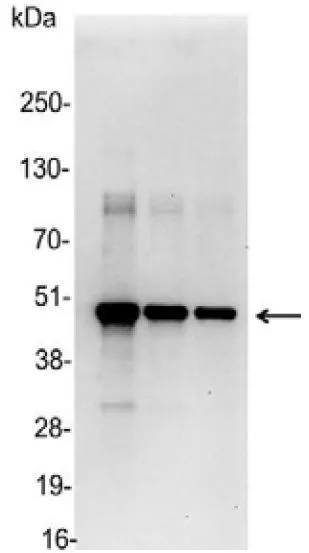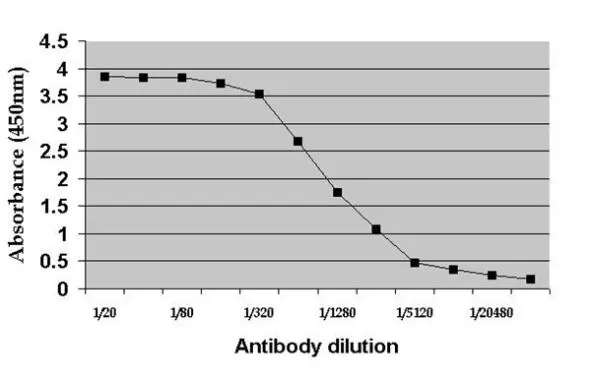c-Myc antibody [33]
GTX17356
ApplicationsImmunoFluorescence, ImmunoPrecipitation, Western Blot, ImmunoCytoChemistry, ImmunoHistoChemistry, ImmunoHistoChemistry Frozen
Product group Antibodies
TargetMYC
Overview
- SupplierGeneTex
- Product Namec-Myc antibody [33]
- Delivery Days Customer9
- Application Supplier NoteIF: Use at an assay dependent dilution. IHC-Fr: Use at an assay dependent dilution. Myc is a labile protein, thereforepreotease inhibitors should be used at all times. IP (with and without SDS): Use at an assay dependent dilution. WB: Use at an assay dependent dilution. Detects a band of approximately 49, 64 & 67 kD (predicted molecular weight: 49 kD). 64 and 67kD forms are phosphophorylated. Optimal dilutions/concentrations should be determined by the end user.
- ApplicationsImmunoFluorescence, ImmunoPrecipitation, Western Blot, ImmunoCytoChemistry, ImmunoHistoChemistry, ImmunoHistoChemistry Frozen
- CertificationResearch Use Only
- ClonalityMonoclonal
- Clone ID33
- Concentration1 mg/ml
- ConjugateUnconjugated
- Gene ID4609
- Target nameMYC
- Target descriptionMYC proto-oncogene, bHLH transcription factor
- Target synonymsMRTL, MYCC, bHLHe39, c-Myc, myc proto-oncogene protein, avian myelocytomatosis viral oncogene homolog, class E basic helix-loop-helix protein 39, myc-related translation/localization regulatory factor, proto-oncogene c-Myc, transcription factor p64, v-myc avian myelocytomatosis viral oncogene homolog, v-myc myelocytomatosis viral oncogene homolog
- HostMouse
- IsotypeIgG1
- Protein IDP01106
- Protein NameMyc proto-oncogene protein
- Scientific DescriptionThis gene is a proto-oncogene and encodes a nuclear phosphoprotein that plays a role in cell cycle progression, apoptosis and cellular transformation. The encoded protein forms a heterodimer with the related transcription factor MAX. This complex binds to the E box DNA consensus sequence and regulates the transcription of specific target genes. Amplification of this gene is frequently observed in numerous human cancers. Translocations involving this gene are associated with Burkitt lymphoma and multiple myeloma in human patients. There is evidence to show that translation initiates both from an upstream, in-frame non-AUG (CUG) and a downstream AUG start site, resulting in the production of two isoforms with distinct N-termini. [provided by RefSeq, Aug 2017]
- Storage Instruction-20°C or -80°C,2°C to 8°C
- UNSPSC12352203
References
- Glucose-regulated protein 58 modulates beta-catenin protein stability in a cervical adenocarcinoma cell line. Liao CJ et al., 2014 Aug 1, BMC CancerRead more







![FACS analysis of transfected LST-1-c-Myc in HEK-293 cells (red) compared with non-transfected HEK-293 cells (blue) using GTX10826 c-Myc antibody [9E10] (FITC).](https://www.genetex.com/upload/website/prouct_img/normal/GTX10826/GTX10826_20191025_AP_006_112_w_23060120_166.webp)
